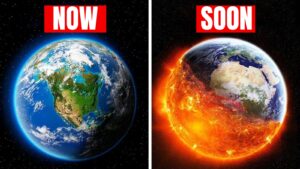Sand dunes, droughts, and sand storms have often been perceived to characterize deserts. These regions of vast sand and rock land space barely have any vegetative coverings, although a few oases might be discovered dispersed within its proximity. Desolate and dry it might be perceived, however, whispers suggest the dawn of an age where technology might cushion nature towards sustainable development to serve the generations to come. In an era that is beginning to appreciate the eagerness nature is willing to serve its stewards, exploration of renewable energy is rapidly gaining accreditation, ever so firmly to an extent of the conception of an impressively audacious feat by scientists: to garnish the blazing hot Saharan desert with a stream of solar panels, to tap into the God-given infinite energy. As a matter of fact, the ten largest solar facilities in the world are all located in deserts or dry regions.
The Saharan desert is being touted as the targeted desert should these theories materialize, perhaps, rightfully so as it is the largest desert in the world. It spans 10 different countries in three different time zones. Its massive size would rank it fifth in the world had it been a country, as its boundaries make it bigger than Brazil yet slightly smaller than the Chinese nation and the United States.
The Annual sunshine hours map of the world shows that although there is notable hot spot across the world such as North America, South America, and southern Africa, however, the Sahara desert receives by far the highest sunshine in the world, and gets absolutely massacred by sunlight throughout the day. The Saharan desert extends over an estimated area of 9 million km2, within which each square meter of the crust is exposed to between 3000 to 4000-kilowatt hours of solar energy annually. This translates directly to over 22 billion gigawatt-hours (GWh) a year.
To put this into perspective, those areas receiving 4000 hours of sunshine yearly in the Sahara desert has nearly four times the amount of annual sunlight that Germany gets in a year. This can be attributed to the fact that the Sahara desert is much directly along the tropic of cancer which means the sunshine falls most of the year directly over it and also clouds never form or even exist over the entire desert. This means all that sunlight is never interrupted, making the Sahara desert the best place on earth to place solar panels and develop solar farms.
This then brings the most asked question about what would happen, if we covered the entire desert in solar panels. What amount of energy, would we be able to produce, and how would this affect our planet. On paper, the Sahara Desert has the potential to be a global renewable energy powerhouse, capable of supplying energy in excess of 2,000 times greater than the world’s global energy sources whose output does not exceed 100,000 GWh annually.
In a research data provided by the German Aerospace Centre in 2005, just a little square as shown on the map, when covered with solar panel can supply the entire energy needed by Germany. The next square on the map can meet Europe’s energy demand. More interestingly, when this area is enlarged a bit with solar panels, the energy generated can supply the entire world with electricity.
Currently, two tenable technologies have been proposed as viable production mediums. These are concentrated solar power (CSP) and standard photovoltaic solar panels. As with any machine or technology, these energy-generating solutions have their pros and cons.
Concentrated solar power (CSP) is designed to focus the sun’s energy into specific spots or receptors, using lenses and mirrors. Fashioned with intrinsic qualities optimized to function ideally in constant sunny and hot weather. Heat received is converted into mechanical energy with the aid of steam turbines and finally to electrical energy. Large amounts of energy are harnessed, even in molten salt form, permitting the uninterrupted generation of electricity even without the searing sun energy in the relative cool that comes at night.
Morocco is currently home to the world’s largest concentrated solar power plant having invested nearly $3 billion in the Noor Power project, with an estimated capacity of 510 Mega Watts located on 6180 acres of land. The country aims to develop additional plants in the Sahara desert that will collectively generate more than 2000 megawatts of electricity production, which will be distributed to Europe through undersea cables.
Morocco has been working on this ambitious renewable energy program since 2009, with the objective of maximizing renewable energy’s contribution to the national energy network to 38 percent by the end of 2022 and 52 percent by 2030. Other neighboring countries such as Algeria and Tunisia have also outlined multibillion concentrated solar power plants projects, with several contracts awarded or in the tendering face.
Although necessary as the standard means for CSP solar energy generation, the mode of operation of the steam turbines is generally a complex technology. Also, lenses and mirrors implemented require regular washing and cleaning with water to remove dust and impurities produced by sand storms among others.
Photovoltaic solar panels or flat sun-scorched surfaces are rich in silicon, a material whose property as a semiconductor renders it a valuable component for photovoltaic cells even more so as silicon solar cells provide optimum efficiency at affordable costs, meanwhile proving its durability evident from a long lifespan. It is the most widely used type of solar power because it can be connected to the grid or distributed for small-scale use on individual buildings whiles producing adequate output in cloudy conditions. On another hand, sand storms could cover the panels thereby reducing their efficiency even further.
The Egyptian government recognizes the importance of a sustainable energy mix in order to meet rising demand, while also transitioning to a more environmentally sustainable and diverse electrical industry, has invested massively in photovoltaic technology. The country is targeting 22% installation across the country, as compared to only 3% for CSP solar energy generation by 2030. In October 2018, IRENA declared that by 2030, Egypt can use renewable energy to supply 53% of its electricity mix.
Depending on the weather, both technologies (that is CSP solar energy generation or photovoltaic technology may require some water to clean the mirrors and panels, making water an important factor to consider. Thus many experts have flirted with the potential of combining the two main technologies to create a hybrid system.
As tantalizing as these theoretical rationales may seem, the physical transcendence of the Saharan desert into a massive continental and global solar power hub would obligate the need to overcome dominant political, regulatory, environmental, and technological hurdles. First of all, the possibility of reaching a united front with regards to legislation and policies might prove difficult, especially as the Sahara is home to a number of nations, including a tense Libyan nation that is currently unstable.
With a heightened emphasis on sustainable development, it is vital to consider the environment whenever engaging in massive energy-generating projects. This notion has forced researchers to conduct several feasibility studies on the global impacts a solar park sprawled across the Sahara Desert could administer. Black surfaces are potent at absorbing light, which is apparently portrayed by the highly absorbent black surface of the large solar panels. These surfaces are adaptations that enhance the efficiency of the solar panels, although only a meager 15% of the energy received is converted electricity. Excess energy is allowed back into the atmosphere, consequently heating the atmosphere and contributing significantly to an alteration in climate.
In a thinly populated and barren desert, these installations would have had little or no significance if the effects were felt domestically, yet, for successful energy generation, the configurations ought to expend colossal landmass, spanning thousands of square kilometers. Air circulation in the atmosphere from an area of this size will breeze re-emitted heat across the region, continent, and even globe, causing threatening consequences on the environment.
Research also highlights that the skyrocketed local temperatures will raise humidity levels in the atmosphere leading to higher rainfall tendencies which might be all well and good for a millennium, particularly for the sprouting of vegetation and biodiversity. However, this might produce inadvertent effects. Nonetheless, with the capacity to generate energy in equivalence to over 36 billion barrels of oil per day which is proportional to five barrels per person, this transcendence if ever achieved could yield as much energy as the entire African continent has the capacity to with relatively low or no carbon dioxide emissions.
Due to the looming potency associated with transforming deserts into energy hubs, scientists and other high-profile figures have courted the concept of studying the impacts desert solar systems could have on local and global energy demand.
In the United States, founder, CEO, and Chief Engineer at SpaceX, Elon Musk stated in 2017 at the National Governors Association Summer Meeting that a small portion of a sunny state could theoretically power the entire country with solar panels- outlining the possibility to power the entire states using 100 by 100 miles solar panels configured in corners of Nevada, Texas or Utah, possibly. Other conglomerates have attempted to achieve this herculean feat including Desertec, a project announced in 2009 that quickly attracted a large amount of funding from various banks and energy companies before largely collapsing five years later when most investors pulled out due to high costs.
A variety of political, commercial, and social factors, including a lack of rapid development in the Saharan region, hinder such ambitious projects. In summary, large-scale solar projects across the Sahara desert have the potential to power entire countries and continents in theory, yet reality proposes significant obstacles to overcome. However, with the fast pace at which new technologies are being developed in recent years, it’s just a matter of time to see how the Sahara desert can power the entire world.











